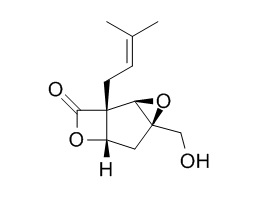Vibralactone B
Vibralactone B shows antibacterial activity, it can inhibit significantly the growth of E. coli and Pseudomonas aeruginosa, with MBC values of 50 and 100 ug/mL, respectively.
Inquire / Order:
manager@chemfaces.com
Technical Inquiries:
service@chemfaces.com
Tel:
+86-27-84237783
Fax:
+86-27-84254680
Address:
1 Building, No. 83, CheCheng Rd., Wuhan Economic and Technological Development Zone, Wuhan, Hubei 430056, PRC
Providing storage is as stated on the product vial and the vial is kept tightly sealed, the product can be stored for up to
24 months(2-8C).
Wherever possible, you should prepare and use solutions on the same day. However, if you need to make up stock solutions in advance, we recommend that you store the solution as aliquots in tightly sealed vials at -20C. Generally, these will be useable for up to two weeks. Before use, and prior to opening the vial we recommend that you allow your product to equilibrate to room temperature for at least 1 hour.
Need more advice on solubility, usage and handling? Please email to: service@chemfaces.com
The packaging of the product may have turned upside down during transportation, resulting in the natural compounds adhering to the neck or cap of the vial. take the vial out of its packaging and gently shake to let the compounds fall to the bottom of the vial. for liquid products, centrifuge at 200-500 RPM to gather the liquid at the bottom of the vial. try to avoid loss or contamination during handling.
Plant Archives2020, 2(1),2929-2934
Foods.2023, 12(6):1227.
Front Neurosci.2019, 13:1091
Int J Mol Sci.2020, 21(8):2790.
Asian J of Pharmaceutical&Clinical 2018, 11(2)
Phytomedicine.2019, 67:153159
American Association for Anatomy2020, doi: 10.1002.
Naunyn Schmiedebergs Arch Pharmacol.2017, 390(10):1073-1083
Universite de Bordeaux2017, 2017BORD0867
Anat Rec (Hoboken).2021, 304(2):323-332.
Related and Featured Products
Food Chem Toxicol. 2017 May 18. pii: S0278-6915(17)30264-8.
Antifungal activities of secondary metabolites isolated from liquid fermentations of Stereum hirsutum (Sh134-11) against Botrytis cinerea (grey mould agent).[Pubmed:
28528973]
METHODS AND RESULTS:
Extracts obtained from liquid mycelial fermentations of the Chilean fungus Stereum hirsutum (Sh134-11) showed antifungal activity against Botrytis cinerea. Two types of extracts were obtained: EtOAc-extract (liquid phase) and MeOH-extract (mycelial phase). Plate diffusion assay showed that EtOAc-extracts were more active than MeOH-extracts. A large-scale fermentation of Sh134-11 and chromatographic methods allowed to isolated four compounds: MS-3, Vibralactone, Vibralactone B and Sterenin D. Only Sterenin D showed antifungal activity against B. cinerea in the tests performed. Effects on the mycelial growth of B. cinerea showed that Sterenin D showed inhibition at 1000-2000 μg/mL reaching 67% and 76% respectively. Sterenin D was more effective to control the sporogenesis, inhibiting in 96% the sporulation at 500 μg/mL. Assays showed that Sterenin D exhibited a minimal fungicidal concentration (MFC) of 50 μg/mL and minimal inhibitory concentration (MIC) at 20 μg/mL.
CONCLUSIONS:
Our study indicated that submerged fermentations of Chilean S. hirsutum (Sh134-11) produced extracts with antifungal activity and Sterenin D is responsible for this activity, which could be used as possible biofungicides alternative to synthetic fungicides.
Z Naturforsch C. 2015;70(3-4):97-102.
Bioactive compounds isolated from submerged fermentations of the Chilean fungus Stereum rameale.[Pubmed:
26020559 ]
METHODS AND RESULTS:
Liquid fermentations of the fungus Stereum rameale (N° 2511) yielded extracts with antibacterial activity. The antibacterial activity reached its peak after 216 h of stirring. Bioassay-guided fractionation methods were employed for the isolation of the bioactive metabolites. Three known compounds were identified: MS-3 (1), vibralactone (2) and Vibralactone B (3). The three compounds showed antibacterial activity as a function of their concentration.
CONCLUSIONS:
Minimal bactericidal concentrations (MBC) of compound 1 against Gram-positive bacteria were as follows: Bacillus cereus (50 μg/mL), Bacillus subtilis (10 μg/mL) and Staphylococcus aureus (100 μg/mL). Compounds 2 and 3 were active only against Gram-negative bacteria. The MBC of compound 2 against Escherichia coli was 200 μg/mL. Compound 3 inhibited significantly the growth of E. coli and Pseudomonas aeruginosa, with MBC values of 50 and 100 μg/mL, respectively.
Chem Pharm Bull (Tokyo). 2008 Sep;56(9):1286-8.
Derivatives of vibralactone from cultures of the basidiomycete Boreostereum vibrans.[Pubmed:
18758102]
METHODS AND RESULTS:
Four new natural products possessing vibralactone skeleton, 1,5-secovibralactone (1), Vibralactone B (2), vibralactone C (3) and acetylated vibralactone (4), together with known compound vibralactone (5), had been isolated from cultures of the basidiomycete Boreostereum vibrans.
CONCLUSIONS:
The structures of 1-4 were elucidated on the basis of spectroscopic methods. The absolute configuration of 1 was suggested to be S by computational methods.



